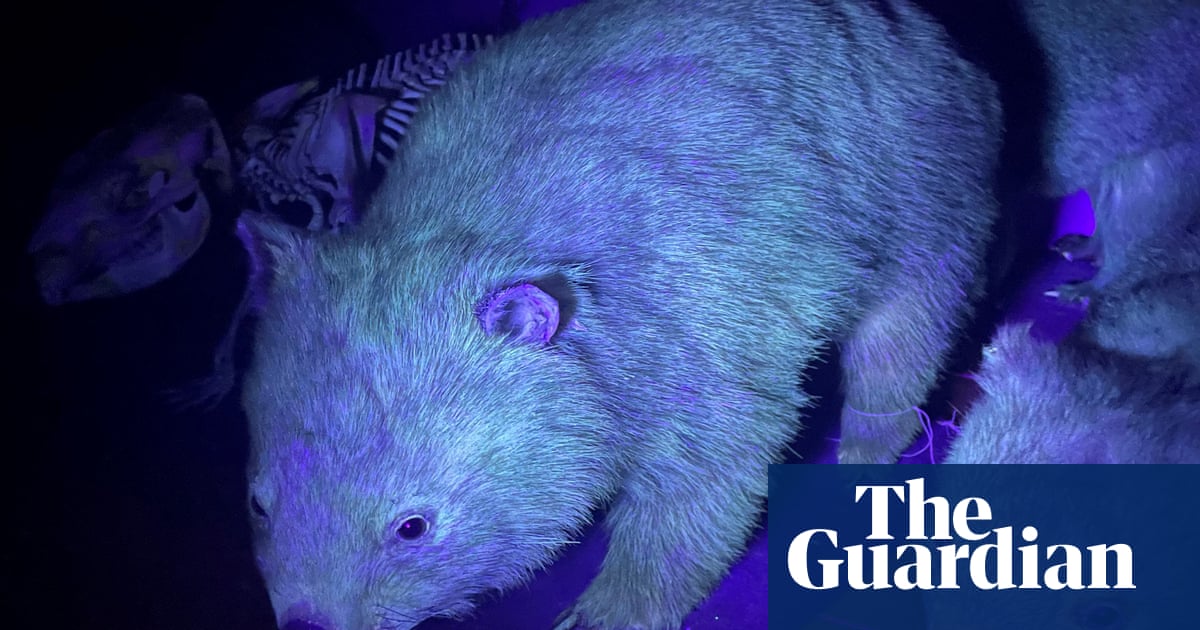
Fluorescence in mammals is much more common than previously thought, new research suggests.
A luminous property, fluorescence has been described in recent years in Australian marsupials including platypuses, wombats, Tasmanian devils and echidnas.
But scientists now believe the quality is widespread across mammals after researchers studied 125 species and found all of them showed some form of fluorescence. The researchers found 107 of the 125 species (86%) had fur that glowed under UV light.
The 125 species represent all 27 living mammalian orders and about half of all living mammal families.
Fluorescence was most common and most intense among nocturnal species, the researchers found, but it was also present in diurnal animals, which are active during the daytime, including the mountain zebra and the polar bear.
“We didn’t know that so many mammals had glowing skin or glowing fur,” said Dr Kenny Travouillon, curator of mammalogy at the Western Australian Museum and the study’s lead author.
Animals that are fluorescent appear to glow under UV light because proteins in their fur or skin absorb the radiation and emit it as visible light.
“The UV light hits the hair or skin, and proteins … shift the light into the visible range,” Travouillon said. “That’s why they appear blue or green, or even red.”
All mammals including humans have fluorescent teeth, and many also have fluorescent nails, Travouillon said. The dwarf spinner dolphin was the only animal the researchers analysed whose sole fluorescent body part was its teeth.
The researchers analysed a combination of preserved and frozen animal specimens – mainly from the Western Australian Museum collection – to try to rule out that the glow wasn’t merely an artefact of the preservation process.
The study, published in the journal Royal Society Open Science, noted that “preservation may play a part in the intensity of the fluorescence observed for some specimens”.
Unpreserved frozen platypus specimens were least fluorescent, the team found, with the glow more intense for specimens preserved with borax and even more again for those preserved with arsenic.
“But we did that for other animals and we actually found the opposite – the brighter ones were actually the frozen ones and preservation actually decreased the intensity of the fluorescence,” Travouillon said, citing the koala, Tasmanian devil and echidna as examples.
Linda Reinhold, a zoologist at James Cook University who was not involved in the research, said “if fluorescence of the fur can be significantly underrepresented in [some] museum specimens … it boggles the mind as to what the phenomenon is like in these species in the wild”.
“Although only 86% of the mammals studied had fluorescent fur, they all had at least fluorescent claws or teeth, as we do when we go to a disco.”
Reinhold noted that several of the specimens analysed – including brushtail possums, kangaroos, black rats and European hedgehogs – displayed less colourful fluorescence compared to specimens in previously published research. She questioned whether this discrepancy was geographic or the result of preservation differences.
The exact purpose of fluorescence in mammals is still a mystery, but the study’s authors believe it could be a means to make animals appear brighter and “enhance visual signalling, especially for nocturnal species”.
“Carnivores usually have spots or stripes on their back. I think this could be potentially a way for them to recognise each other within their own species,” Travouillon said.
“But a lot of animals only have this glowing on their bellies, because that’s not visible to predators … maybe members of their species, when they get close, will be able to recognise them.”
The scientists concede that in some species fluorescence is unlikely to play any functional role.
The southern marsupial mole, for example, covered in yellow-white fur, was one of the most fluorescent species they analysed. But the animal is also blind, and the researchers believe the fluorescence is merely a byproduct of not having pigmented fur. White but not other coloured hair in humans is also innately fluorescent.
“Fluorescence is unlikely to be important for some flying mammals such as microbats that use echolocation to navigate and locate prey,” the researchers added.
Other scientists have expressed reservations about the significance of biofluorescence, given that the amount of UV light reaching Earth decreases at night-time.
Biofluorescence in non-human mammals was first reported in 1911, in European rabbits.
“A lot of people might want to get a UV light and try it on their pets,” Travouillon said. “Just one word of caution – they shouldn’t put the UV light in the eyes of their pets, because that does damage the eyes.”












